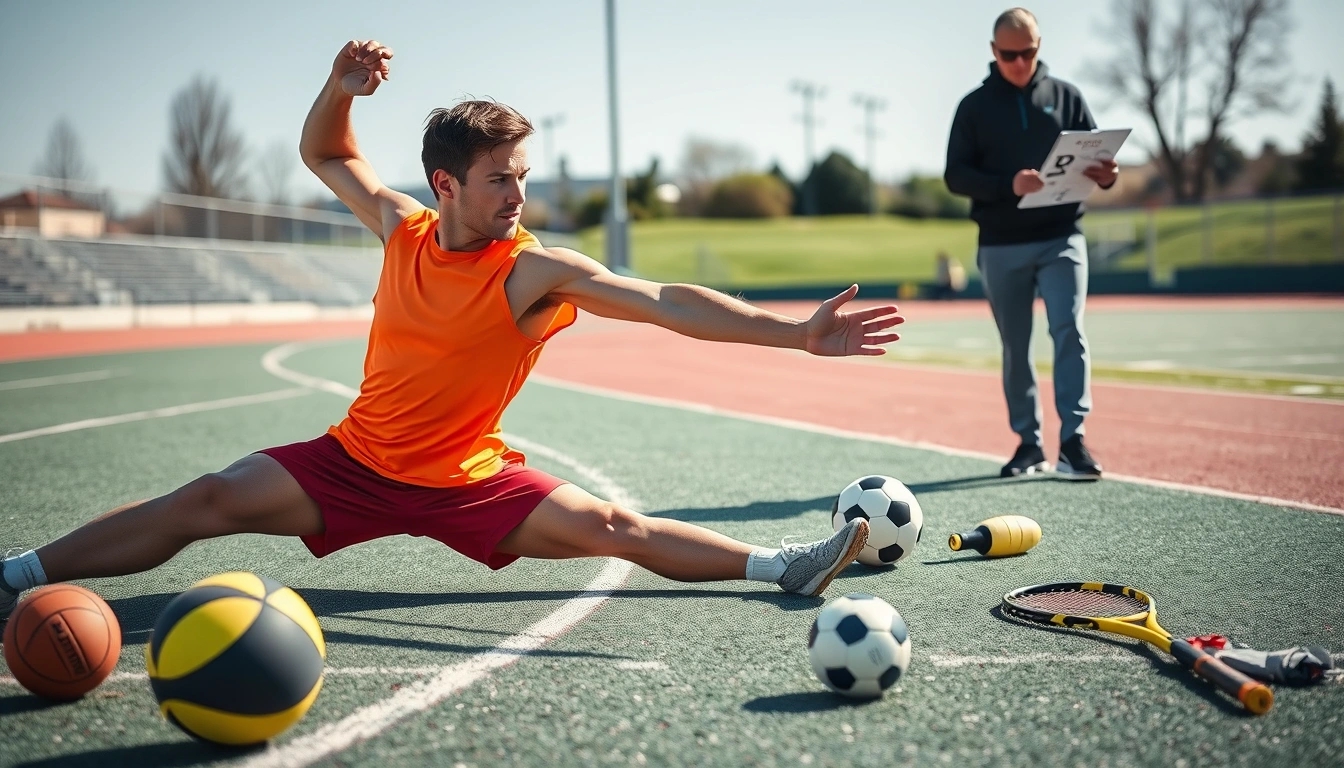Getting your body ready before diving headfirst into any training session isn’t just some annoying ritual your coach keeps nagging about — it’s absolutely vital. Yet, let’s be honest, a lot of folks just skip it or do a half-hearted jog around the gym like that’s enough. Spoiler alert: it’s not. Warming up properly can make the difference between smashing your workout or ending up sidelined with an injury. So, why bother? And how do you actually do it right without feeling like you wasted precious energy before the real fun starts? Let’s unpack this.
- Why bother warming up? First off, your muscles don’t magically spring to life the moment you start lifting or sprinting. They need a gentle nudge — a gradual increase in blood flow, heart rate, and muscle temperature. This preps your body for the physical stress ahead and lowers the risk of pulls, strains, or worse. Think of it like warming up an engine on a cold morning; you wouldn’t just slam the gas pedal, right?
- Time is precious, so keep it efficient. You don’t need a 30-minute warm-up unless you’re prepping for a marathon or some ultra-endurance event. Usually, 5 to 10 minutes of targeted moves is enough to get you primed and ready.
| Warm-Up Component | Purpose | Example |
|---|---|---|
| General Cardio | Elevate heart rate and increase blood flow | Jogging, jumping jacks, or cycling for 3-5 minutes |
| Dynamic Stretching | Improve joint mobility and muscle flexibility | Leg swings, arm circles, walking lunges |
| Sport-Specific Drills | Activate muscles used in your workout | Bodyweight squats for lifters, dribbling drills for basketball players |
Now, let’s be real — some people swear by static stretching before working out, holding those stretches for ages. But here’s the kicker: static stretching before intense activity can actually hurt your performance. It’s like trying to stretch a rubber band and then immediately snap it; not the best idea. Instead, save those deep stretches for after your training when your muscles are warm and more pliable.
Quick Warm-Up Routine (7 minutes total):1. 2 minutes light cardio (jumping jacks or brisk walking)2. 3 minutes dynamic stretches (leg swings, arm circles)3. 2 minutes sport-specific movements (bodyweight squats, shadow boxing)
If you’re wondering whether you’ve warmed up enough, here’s a simple test: you should feel warmer and a bit breathy but not tired. Your muscles should feel loose, not tight or sore. If you’re already gasping for air or dripping sweat before the main event, you probably overdid it.
In short, warming up isn’t some optional extra — it’s the foundation for a solid workout. Skipping it? That’s just asking for trouble. So, next time, don’t half-ass your warm-up. Give it the respect it deserves, and your body will thank you with better performance and fewer injuries.
Remember: Warming up smart beats warming up long. Quality over quantity, always.
Why Warm-Ups Are More Than Just Routine
Alright, let’s get real for a second. Warm-ups? Yeah, they’re often that annoying thing you wanna skip when you’re itching to get straight into the heavy lifting or sprinting. But here’s the kicker — warm-ups aren’t just some boring, time-wasting ritual your coach forces on you. Nope. They’re actually the unsung heroes of your entire training session. Skip ’em, and you’re basically asking for trouble. And I’m not just talking about a little muscle soreness — think torn ligaments, pulled muscles, or worse. Yikes.
So, why do warm-ups matter so much? First off, they crank up your body temperature, which sounds trivial but is actually a big deal. Warmer muscles stretch better, contract stronger, and recover faster. Imagine trying to run a marathon in winter gloves — your hands wouldn’t work right, right? Same goes for your muscles. Plus, warm-ups get your heart pumping and blood flowing, which means more oxygen and nutrients to your muscles right when you need them. It’s like priming a pump before you start watering a garden.
- Injury Prevention: Cold muscles are stiff and more prone to strains. Warm-ups loosen those suckers up and prepare your joints for action.
- Improved Performance: A proper warm-up enhances your speed, strength, and coordination. You’ll actually perform better — no joke.
- Mental Prep: It’s not just physical. Warming up helps you focus, get in the zone, and mentally map out your workout.
Now, I get it — sometimes you’re in a rush, or you feel like you’re wasting precious seconds. But trust me, a quick 5-10 minute warm-up can save you hours of downtime from injuries or poor performance.
| Benefit | Why It Matters | Result |
|---|---|---|
| Increased Muscle Temperature | Improves elasticity and contraction speed | Better movement, less risk of tears |
| Enhanced Blood Flow | Delivers oxygen & nutrients quickly | More endurance and less fatigue |
| Joint Lubrication | Reduces friction and stiffness | Smoother, safer motions |
| Neuromuscular Activation | Prepares brain-muscle communication | Sharper coordination and reaction time |
Okay, but what about those who say, “I’ve been working out for years and never warmed up, and I’m fine!”? Sure, some folks get lucky, but most are just tempting fate. Think of it like driving a car without warming up the engine on a cold day — you might get away with it, but eventually, things will break down.
Here’s a little secret: the best warm-ups are dynamic — meaning you’re moving, not just standing around stretching like a bored cat. Leg swings, arm circles, light jogging, jumping jacks — these get your muscles firing and your heart racing without draining your energy.
Quick Warm-Up Checklist:- 3-5 minutes light cardio (jog, jump rope)- Dynamic stretches (leg swings, arm circles)- Sport-specific drills (light passes, bodyweight squats)
So next time you’re tempted to skip warming up, remember it’s not just about tradition or being “old school.” It’s about setting yourself up for success — and avoiding that painful “I told you so” moment from your body.
In short: warm-ups are your workout’s best friend. Treat them right, and your body will thank you with better performance and fewer injuries. Don’t be that guy who skips the warm-up and ends up sidelined. Warm up smart, play hard.
Dynamic vs Static Stretching: What’s the Real Deal?
Alright, let’s cut through the noise about stretching because, honestly, it’s a jungle out there. You’ve probably heard the terms dynamic and static stretching tossed around like they’re some kind of magical elixirs for athletes. But if you’re scratching your head wondering which one to do and when, you’re not alone. Let’s break it down and get to the bottom of this stretching saga.
First off, dynamic stretching is all about movement. Think of it as warming up your muscles with controlled, active motions — leg swings, arm circles, walking lunges, that kind of jazz. It’s like telling your body, “Hey, get ready, we’re about to move!” This type of stretching gets your blood flowing, raises your heart rate, and loosens up the joints. If you’re gearing up for a workout or a game, dynamic stretching is your go-to. It’s the pre-party before the main event.
On the flip side, we have static stretching. This is the slow and steady type where you hold a stretch for, say, 20 to 30 seconds without bouncing around. Think hamstring stretch, calf stretch, or the classic butterfly stretch. It’s more about lengthening the muscles and improving flexibility over time. But—and here’s the kicker—static stretching is best saved for after your workout, during your cool-down. Doing it before intense activity can actually dull your muscle power and make you less explosive. Yeah, it’s a bit counterintuitive, but science backs it up.
| Stretching Type | When to Use | Benefits | Common Mistakes |
|---|---|---|---|
| Dynamic Stretching | Before workout or sports | Increases blood flow, warms muscles, improves mobility | Too fast or jerky movements, skipping warm-up altogether |
| Static Stretching | After workout or during cool-down | Enhances flexibility, aids muscle recovery, reduces soreness | Doing it pre-exercise, holding too briefly or too long |
Now, you might be wondering: “Can I just pick one and call it a day?” Well, no. Both have their place, but timing is everything. Starting your session with dynamic stretches wakes you up physically and mentally, prepping your muscles for action. Think of it like revving an engine before hitting the gas. Then, once you’ve crushed your workout, static stretches help calm things down, reduce tightness, and improve long-term flexibility.
Here’s a quick list to remember:
- Dynamic stretching: leg swings, arm circles, torso twists, walking lunges
- Static stretching: hamstring hold, quad stretch, calf stretch, shoulder stretch
And if you’re pressed for time, no worries. Just do a 5-10 minute dynamic warm-up focusing on the muscle groups you’ll be using. Save the static holds for later when you’re chilling post-workout.
In the end, stretching isn’t rocket science, but it’s easy to mess up if you don’t know what you’re doing. So, next time you’re tempted to skip the warm-up or dive straight into static stretches before training, remember this little nugget: dynamic gets you ready, static helps you recover. Simple as that.
Got questions about your specific sport or routine? Hit me up, and we’ll sort out a warm-up plan that’s actually worth your time.

Top 5 Warm-Up Exercises for Every Athlete
Alright, let’s cut to the chase — warming up before you hit the field, track, or gym is not just some annoying ritual your coach forces on you. It’s actually the secret sauce to getting your body ready to crush it without ending up on the bench nursing an injury. Whether you’re a runner, weightlifter, or part of a team sport, these five warm-up moves will have your muscles buzzing and your heart revving in no time.
- Jumping Jacks: Yeah, yeah, they look like something from a 3rd-grade PE class, but don’t underestimate them. Jumping jacks get your heart rate up fast and loosen up your joints so you’re not stiff as a board when you start. Plus, they’re easy to do anywhere — no fancy equipment needed.
- Leg Swings: Swing those legs like you’re trying to knock a fly off the wall. This move isn’t just about stretching; it’s about waking up your hip flexors and improving balance. Just a heads up — if you do these wrong, you might feel more awkward than warmed up. So, keep your torso steady and swing smoothly.
- Arm Circles: Don’t roll your eyes just yet. Arm circles are a simple yet effective way to get blood flowing to your shoulders and upper back. Start small and gradually make bigger circles. It’s a great way to avoid that annoying shoulder pain halfway through your workout.
- High Knees: Think of it as jogging in place but with a bit more swagger. High knees really pump your heart and engage your core, prepping your body for explosive moves. Just don’t go full sprint right away — ease into it.
- Walking Lunges: These bad boys stretch and strengthen your legs simultaneously. They’re perfect for activating your glutes and quads, which are usually the stars of the show in any sport. Plus, since you’re moving forward, it’s a more dynamic stretch than just standing there.
| Exercise | Primary Benefit | Duration/Reps |
|---|---|---|
| Jumping Jacks | Increase heart rate, loosen joints | 30 seconds |
| Leg Swings | Improve hip mobility, balance | 15 swings each leg |
| Arm Circles | Warm up shoulders & upper back | 20 forward, 20 backward |
| High Knees | Boost heart rate, engage core | 30 seconds |
| Walking Lunges | Activate legs & glutes dynamically | 10 lunges each leg |
Look, I get it. Sometimes you just want to skip the warm-up and jump straight into the heavy lifting or sprinting like a maniac. But trust me, your body will thank you later. These moves aren’t about wasting time — they’re about maximizing your performance and minimizing the chance of pulling a muscle or worse. And if you think five minutes is too much, well, you’re probably the same person who thinks pizza counts as a vegetable.
So next time you’re gearing up for a session, give these exercises a shot. They’re quick, effective, and won’t make you look like a total goofball in front of your teammates. Your muscles will be firing on all cylinders, your heart will be ready to pump, and you’ll feel like you actually know what you’re doing. Warm-ups aren’t just a formality — they’re your body’s best friend when it comes to training smart.
Pro Tip: Mix and match these exercises depending on your sport or mood. Running? Focus more on leg swings and high knees. Weightlifting? Arm circles and walking lunges will do the trick. The key is to get moving and get warm.
Remember, no one ever warmed up their way to a world record by skipping these basics. So, don’t be that person. Warm-up like a pro, train like a beast.
Jumping Jacks and Their Surprising Benefits
Jumping jacks—yeah, those old-school moves you did in gym class—might just be the unsung heroes of your warm-up routine. You might be thinking, “Really? Those? They’re so basic.” But hold up, don’t brush them off just yet. These simple, no-frills exercises actually do a lot more than make you look like you’re trying to scare off a swarm of bees.
First off, jumping jacks are an instant heart rate booster. Within seconds, your ticker’s pumping faster, blood is rushing through your veins, and your body’s waking up from its slumber. This is crucial because a warm heart means your muscles get more oxygen and nutrients, which means they’ll perform better and be less prone to injury. You don’t want to jump straight into heavy lifting or sprinting with a cold body—that’s just asking for trouble.
But here’s the kicker: jumping jacks aren’t just about cardio. They’re a full-body joint loosener. Your shoulders, hips, knees, and ankles all get a gentle wake-up call. Imagine your joints as rusty hinges on an old door—jumping jacks are the WD-40 that gets everything moving smoothly again. This is why they’re perfect for kicking off any warm-up session. You don’t need fancy equipment or a ton of space, just a few minutes, and you’re good to go.
- Quick heart rate increase: Gets your blood pumping in no time.
- Joint mobility: Loosens up shoulders, hips, knees, and ankles.
- Full-body activation: Engages multiple muscle groups simultaneously.
Now, before you roll your eyes and say, “But jumping jacks are boring,” consider this: they’re also a sneaky way to improve coordination and rhythm. The pattern of arms and legs moving in sync forces your brain and body to work together. If you’ve ever felt clumsy or off-balance during your workouts, adding jumping jacks to your warm-up might just fix that.
| Benefit | Why It Matters |
|---|---|
| Heart Rate Boost | Prepares cardiovascular system for exercise |
| Joint Mobility | Reduces injury risk by warming up joints |
| Muscle Activation | Engages muscles for better workout performance |
| Coordination | Improves motor skills and balance |
Of course, like anything, jumping jacks aren’t a magic bullet. If you have joint problems or certain injuries, they might not be the best choice. But for most folks, they’re a quick, effective, and downright fun way to get moving. So next time you’re tempted to skip your warm-up or just stretch lazily, throw in some jumping jacks instead. Your body will thank you, even if your brain grumbles a bit about the “old-school” vibes.
In short? Don’t underestimate the power of jumping jacks. They’re simple, efficient, and pack a punch when it comes to prepping your body for whatever workout madness you’ve got planned. And hey, if nothing else, they’re a great excuse to jump around like a kid again—no shame in that game.
Leg Swings: More Than Just a Leg Stretch
Alright, let’s get real about leg swings. You’ve probably seen them in the gym or on the field, maybe even tried them yourself. They look simple enough—just swing your leg back and forth, right? Well, not quite. Leg swings are actually a powerhouse move when it comes to hip mobility and balance, two things that are absolutely essential if you want to explode off the line, jump higher, or just move like a human being without feeling like a rusty robot.
But here’s the kicker: most folks mess up the technique. And no, it’s not just about flinging your leg around like a wild pendulum. If you’re not careful, you’re wasting your time and might even be setting yourself up for some awkward strains or pulls. Let’s break down how to do leg swings the right way, so you don’t end up being “that guy” who looks like they’re trying to swat a fly with their foot.
- Start with control: Don’t just go full throttle from the get-go. Begin with small, controlled swings to warm up the hip joint. It’s like testing the waters before diving in.
- Keep your torso steady: No wobbling or leaning over. Your upper body should stay upright and stable. If you’re rocking back and forth, you’re cheating yourself out of the balance benefits.
- Engage your core: This isn’t just about the leg. Your core muscles help stabilize you, so tighten that midsection like you’re bracing for a punch.
- Focus on range of motion: Gradually increase how high or far you swing your leg, but don’t force it. Pushing too hard can cause injury.
| Common Mistake | Why It’s Bad | How to Fix It |
|---|---|---|
| Swinging too fast | Reduces control and increases injury risk | Start slow, build up speed gradually |
| Leaning torso | Compromises balance and hip activation | Keep upper body upright and core tight |
| Not warming up first | Increases chance of muscle strain | Do light cardio or dynamic stretches before |
Here’s a little secret: leg swings do way more than stretch your legs. They activate the hip flexors, glutes, and the muscles around your pelvis, which are often neglected but super important for any explosive movement. Think sprinting, kicking, or even just changing direction quickly on the court. If those muscles are tight or weak, you’re basically running with a flat tire.
One more thing—balance. If you’re wobbling all over the place, you’re not just looking silly, you’re missing the point. Leg swings challenge your stability, forcing your brain and muscles to sync up and keep you upright. This neuromuscular coordination is gold for athletes and weekend warriors alike.
So next time you’re warming up, don’t just half-ass those leg swings. Nail the technique, and your hips will thank you. You’ll move better, feel stronger, and maybe even avoid that nagging groin pull that’s been bugging you forever.
Quick Leg Swing Warm-Up Routine:
- Hold onto a wall or sturdy object for balance- Swing leg forward and backward 10 times, starting slow- Swing leg side to side 10 times, controlled motion- Switch legs and repeat- Progressively increase range and speed as you feel comfortable
In the end, leg swings are a simple but mighty tool in your warm-up arsenal. Master them, and you’re one step closer to moving like a pro instead of a clumsy mess. Trust me, your hips will love the attention!
How Long Should Your Warm-Up Last?
Timing your warm-up is an art, not a science – or at least that’s what many athletes would tell you after a few too many rushed mornings or painstakingly long sessions that felt like a pre-workout workout. The truth is, finding the perfect warm-up duration is crucial, but it’s also wildly misunderstood. Too short, and you’re basically walking into your workout with cold muscles, risking injury like a rookie. Too long, and you’re wasting precious energy that could be better spent crushing your main session. So, what’s the magic number? Let’s break it down.
First off, if you’re thinking “I don’t have time for warm-ups,” well, that’s a fast track to trouble. Skipping or skimping on warming up is like trying to start a car on a freezing winter morning without letting the engine run a bit first – it just won’t work smoothly. Most experts agree that a warm-up should last between 5 to 15 minutes. That’s a pretty wide range, but it depends on factors like your fitness level, the workout intensity, and even the weather.
- 5-7 minutes: Ideal for light workouts or when you’re pressed for time. Quick dynamic movements like jumping jacks or leg swings can do the trick here.
- 8-12 minutes: Sweet spot for most training sessions, especially if you’re lifting weights or doing moderate cardio.
- 13-15+ minutes: Best for intense sports or cold environments where your muscles need more time to get loose.
Now, don’t go thinking you need to clock in a full 15 minutes every single time. That’s a recipe for burnout before you even start. The key is efficiency. Your warm-up should gradually increase your heart rate and mobilize your joints without leaving you gasping for air. If you find yourself panting too hard, you’re probably overdoing it.
| Warm-Up Duration | When to Use | Example Exercises |
|---|---|---|
| 5-7 minutes | Quick sessions, light activity | Jumping jacks, arm circles, light jogging |
| 8-12 minutes | Moderate training, weightlifting | Dynamic stretches, leg swings, high knees |
| 13-15+ minutes | Intense training, cold weather | Full-body mobility drills, sport-specific movements |
Here’s a pro tip: listen to your body. If your muscles feel tight or your joints stiff, don’t rush it. Add a few extra minutes. Conversely, if you feel ready and loose after 5 minutes, no need to drag it out. It’s not a one-size-fits-all deal.
And let’s be honest, sometimes you just gotta wing it. Maybe you overslept, or your schedule’s nuts – just do what you can. Even a couple of minutes of movement beats nothing. But remember, the goal is to prepare your body, not exhaust it. So, next time you’re tempted to skip the warm-up or turn it into a marathon, think about your muscles and joints thanking you later.
In the end, the warm-up isn’t just a box to tick off. It’s your body’s way of saying, “Hey, I’m ready for this!” Nail the timing, and you’re already halfway to a killer workout.
Common Warm-Up Mistakes and How to Avoid Them
Alright, let’s get real for a second — warming up before you hit the gym or the field isn’t just some annoying ritual your coach made up to torture you. It’s actually crucial. But here’s the kicker: a lot of folks mess this part up big time, and it can totally wreck your workout before you even break a sweat. So, what are these classic blunders, and how do you dodge them like a pro? Let’s break it down.
- Static Stretching at the Wrong Time: You know that old-school move where you stand still and hold a stretch for like 30 seconds? Yeah, that’s static stretching. The problem? Doing it before you warm up can actually reduce your muscle strength and power. It’s like trying to run a marathon right after sitting on the couch all day. Instead, save static stretches for after your workout when your muscles are warm and more pliable.
- Skipping Cardio Warm-Up: Some people think just jumping straight into lifting or sprinting is fine. Nope. Your heart and lungs need a little warm-up too. Skipping cardio can leave you feeling stiff and increase injury risk. A few minutes of light jogging, cycling, or even brisk walking gets your blood pumping and muscles ready to roll.
- Going Too Hard, Too Fast: Ever seen someone sprint full throttle right off the bat? That’s a recipe for pulled hamstrings or worse. Warm-ups should gradually increase your heart rate and body temperature — not send you gasping for air in 30 seconds. Ease into it, folks.
| Mistake | Why It’s Bad | How to Fix It |
|---|---|---|
| Static Stretching First | Decreases muscle power and performance | Do dynamic stretches before, static after workout |
| Skipping Cardio | Muscles stay cold and stiff, injury risk rises | Include 5-10 minutes of light cardio |
| Jumping In Too Hard | Muscle strains and fatigue | Gradually increase intensity during warm-up |
Now, here’s a little insider tip: a warm-up isn’t just about moving your muscles — it’s also about getting your mind ready. If you’re mentally checked out, no amount of jumping jacks is gonna save your workout. So, use this time to focus, visualize your session, and get pumped.
Top 3 Quick Warm-Up Moves to Avoid Mistakes:1. Light jog or jump rope for 3-5 minutes2. Dynamic stretches like leg swings, arm circles3. Movement-specific drills (e.g., bodyweight squats for leg day)
To wrap it up, don’t let these common mistakes sabotage your hard work. Warm-ups are your foundation — screw them up, and the whole workout shakes. Nail them right, and you’re setting yourself up for success, fewer injuries, and maybe even a personal best. So next time you’re tempted to skip or rush through your warm-up, remember: do it smart, or pay the price later. Your muscles (and your ego) will thank you.
Stay safe, stay smart, and keep moving!

Warm-Up Tips for Different Sports
Not all warm-ups are created equal, and if you think you can just jog a bit and call it a day, well, think again. Different sports demand different muscles, movements, and energy systems to be primed. Your warm-up should be as unique as your sport, or else you might as well be warming up for a nap. Let’s break down some practical, sport-specific warm-up tips so you don’t waste time or risk injury.
- For Runners: Dynamic stretches like leg swings and high knees are your best friends. You want to loosen those hamstrings and calves but also get your heart rate up gradually. Static stretching? Save that for after your run unless you want to feel like a rubber band about to snap.
- For Weightlifters: Forget slow jogging. Instead, focus on joint mobility drills and light sets with the barbell. This wakes up your nervous system and preps your muscles for heavy lifting. Wrist circles, shoulder rotations, and hip openers are clutch here.
- For Team Sports (Soccer, Basketball, etc.): These guys need a mix of agility, speed, and endurance. So dynamic warm-ups with side shuffles, carioca drills, and quick sprints will get you game-ready. Don’t skip the mental prep either—visualize those plays!
| Sport | Warm-Up Focus | Recommended Exercises |
|---|---|---|
| Running | Leg mobility, cardiovascular activation | Leg swings, high knees, butt kicks, light jogging |
| Weightlifting | Joint mobility, nervous system activation | Wrist circles, shoulder rotations, bodyweight squats, light barbell sets |
| Team Sports | Agility, speed, coordination | Side shuffles, carioca, quick sprints, dynamic stretches |
| Swimming | Shoulder mobility, breathing control | Arm circles, scapular push-ups, breathing drills |
Now, if you’re thinking, “Hey, I do a bit of everything, can’t I just do a general warm-up?” Sure, but keep in mind that a warm-up too generic might leave some muscles cold and others overworked. It’s like trying to wear one shoe size for all your feet—awkward and inefficient.
Here’s a quick checklist to customize your warm-up:
- Identify the main muscles and joints used in your sport. If you’re a sprinter, hips and calves are key. If you’re a rower, focus on shoulders and back.
- Include dynamic movements that mimic your sport’s actions. This helps your brain and body sync up for what’s coming.
- Don’t forget mental prep. A few minutes visualizing your performance can be surprisingly effective.
Pro Tip:If you’re short on time, prioritize movements that activate your core and prime your sport-specific muscles.Example: A basketball player might do planks, lunges with twists, and quick feet drills.
To wrap it up, tailoring your warm-up to your sport isn’t just a fancy suggestion—it’s a game changer. Skip the cookie-cutter routines and give your body what it actually needs. You’ll not only reduce injury risk but also feel sharper and more explosive when it counts. So next time you hit the field, court, pool, or gym, warm up like a pro, not like you’re just killing time.
Remember: Your warm-up is the launchpad for your performance, not an afterthought. Treat it right, and your body will thank you.
Quick Warm-Up Routine Table for Busy People
Look, we get it. Life’s hectic, and sometimes the last thing on your mind before smashing a workout is a lengthy warm-up session. But here’s the kicker — skipping it? Not a great idea. Your muscles and joints aren’t just gonna magically prepare themselves while you’re scrolling through your phone. So, what’s the solution? A no-nonsense, five-minute warm-up routine that’s short, sweet, and actually effective. No fluff, no filler, just the essentials to get you moving without wasting a minute.
Why bother with a warm-up at all? Because it’s your body’s way of saying, “Hey, we’re about to do some work here, let’s get ready!” Warming up increases blood flow, improves flexibility, and lowers injury risk. Plus, it mentally gears you up, so you’re not just stumbling into your workout half-asleep.
Here’s a table that breaks down a simple routine that covers all your bases — cardio, mobility, and muscle activation — in just 5 minutes. Feel free to tweak it, but this combo works wonders for almost anyone.
| Exercise | Duration | Purpose | Tips |
|---|---|---|---|
| Jumping Jacks | 1 minute | Raise heart rate, warm up whole body | Keep a steady pace; don’t go full sprint unless you want to gas out early |
| Arm Circles | 30 seconds forward, 30 seconds backward | Loosen shoulder joints, improve mobility | Start small, gradually increase circle size |
| Leg Swings (front to back) | 30 seconds per leg | Activate hips and hamstrings | Hold onto a wall for balance; avoid jerky motions |
| Bodyweight Squats | 1 minute | Wake up glutes, quads, and calves | Keep chest up, knees tracking toes |
| Dynamic Lunges with Twist | 1 minute | Stretch hip flexors, engage core | Step forward, twist torso toward leading leg |
Notice how this routine touches on cardio, dynamic stretching, and muscle activation? That’s the sweet spot. Don’t waste your precious time on static stretches before your workout — they can actually make you less explosive. Save those for the cooldown.
If you’re in a mad rush, even just jumping jacks and leg swings can get your blood pumping and joints moving enough to start training safely. But if you can spare the full five minutes, this routine will have you primed and ready to crush it.
- Pro tip: Use this routine as a template and adjust based on your sport or workout style.
- Don’t rush: The goal is to prepare, not to tire yourself out before the real work begins.
- Consistency beats intensity: Doing a quick warm-up every time is better than skipping it and risking injury.
So next time you’re tempted to jump straight into the heavy lifting or sprinting, remember this: a few minutes of smart warm-up can save you hours of downtime from injuries or poor performance. It’s like oiling the gears before revving the engine — makes everything run smoother.
Bottom line: No excuses. Five minutes. That’s all you need to set yourself up for success. Now, go warm up and then get after it!
The Science Behind Warm-Ups: What Research Says
Alright, let’s cut to the chase — warm-ups aren’t just some hokey ritual your coach insists on before practice. There’s legit science backing up why they’re a game-changer for your performance and injury prevention. But hey, if you’re one of those folks who think skipping warm-ups is a shortcut to greatness, well… you’re playing with fire. Literally.
First off, warming up essentially cranks your body’s engine from idle to ready-to-race mode. Blood flow increases, muscles get warmer and more pliable, and your nervous system starts firing on all cylinders. Studies show that a proper warm-up can improve muscle elasticity and joint mobility, reducing the risk of strains and sprains. So that nagging hammy pull? Yeah, probably because you skipped this step.
| Warm-Up Benefit | Scientific Explanation | Practical Impact |
|---|---|---|
| Increased Muscle Temperature | Warmer muscles contract more efficiently and generate more power. | Boosts sprint speed and jump height. |
| Enhanced Neural Activation | Improves communication between brain and muscles. | Better coordination and reaction times. |
| Improved Joint Lubrication | Synovial fluid production increases, easing joint movement. | Reduces joint stiffness and injury risk. |
Now, don’t get me wrong — there’s a lot of debate about what kind of warm-up is best. Dynamic stretching (think leg swings, arm circles) gets the blood pumping and preps your muscles for action, unlike static stretching (holding a stretch), which if done cold, might actually *reduce* power output. Yeah, science can be a buzzkill sometimes.
- Dynamic stretching is your go-to before high-intensity workouts or sports.
- Static stretching is better saved for post-exercise cooldowns or separate flexibility sessions.
Ignoring warm-ups? That’s basically asking for trouble. Research consistently links skipping warm-ups to higher rates of muscle tears and joint injuries. Plus, your performance takes a nosedive. Think of it like trying to drive a car that’s been sitting in the cold all night — it’s not gonna run smoothly until it’s warmed up.
Here’s a quick rundown of what a science-backed warm-up should include:
- 5 minutes of light cardio (jogging, jumping jacks)- 5-10 minutes of dynamic stretches targeting key muscle groups- Sport-specific drills or movements at gradually increasing intensity
To sum it up, warm-ups are the unsung heroes of every training session. They’re not just fluff or time-wasters; they’re a scientifically proven way to get your body primed and ready to crush it, while keeping injuries at bay. So next time you’re tempted to skip them, remember — the science says you’re being dumb. And your muscles will thank you later.
Stay smart, warm up, and play hard!
Frequently Asked Questions
- Why is warming up before training so important?
Think of your body as a car engine on a cold morning—jumping straight into high speed can cause damage. Warming up gradually increases your heart rate and blood flow to muscles, reducing the risk of injuries and boosting your performance. Skipping this step is like trying to sprint without stretching your legs first—risky and inefficient!
- What’s the difference between dynamic and static stretching?
Dynamic stretching involves active movements that mimic your workout, preparing muscles and joints for action. Static stretching, on the other hand, means holding a stretch for a period, which is better suited for cooling down. Using dynamic stretches before training wakes your body up, while static stretches are like a gentle “good night” to your muscles.
- How long should my warm-up last?
Timing your warm-up is a balancing act. Aim for about 5 to 10 minutes—enough to get your blood pumping but not so long that you drain your energy before the main event. Think of it as the perfect coffee break for your muscles: just right to get them buzzing without overdoing it.
- Can I do the same warm-up for all types of sports?
Not really! Each sport demands different muscle groups and movements. For instance, runners benefit from leg swings and light jogging, while weightlifters might focus more on joint mobility and activation exercises. Tailoring your warm-up is like choosing the right fuel for your car—it ensures you perform at your best.
- What are common mistakes to avoid during warm-ups?
One big no-no is static stretching right before intense activity—it can actually decrease muscle strength temporarily. Also, skipping cardio or rushing through warm-ups can leave you vulnerable to injuries. Remember, a warm-up isn’t a hurdle to jump over; it’s the launchpad for your workout success.
- Are quick warm-ups effective if I’m short on time?
Absolutely! Even a 5-minute warm-up can make a huge difference if done right. Focus on dynamic movements that raise your heart rate and activate key muscles. It’s like a power-up in a video game—short but mighty enough to prepare you for the challenge ahead.












